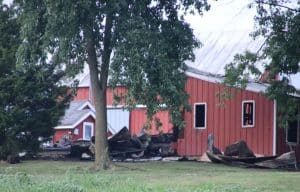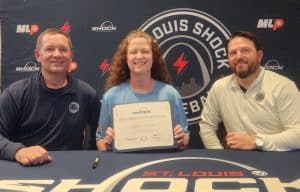Missile site tour provides memories, future dreams
by Soviet bombers. (Alan Dooley photo)
Hundreds took advantage of an opportunity most never had before, visiting the former Nike anti-aircraft missile launch site east of Hecker Thursday and Friday.
More than 200 people visited Thursday and perhaps twice that many came Friday – the last day the acreage and facilities were open for viewing before a July 12 auction at Hecker Community Center.
The 14 acres and all facilities were open for visits. That included three aging buildings and three mind-boggling underground bunkers — called “pits” by the soldiers who served there during the height of the Cold War in the early 1960s.
For many, it was the first visit to a facility they had known since childhood but never had the chance to see for themselves.
Ed Fuhrman, who still lives close by on Beck Road, told of hunting rabbits just outside the double chained link fence topped with coils of barbed wire and soldiers guarding the place.
“We’d be hunting rabbits and see the armed soldiers patrolling between the double-fence perimeter, often with dogs at their sides,” he said. “Our dad cautioned us every time we went: ‘Don’t shoot toward them.’ And we never did. Of course, we wondered what was going on there, but we were more concerned with the rabbits.”
Fuhrman was awed finally to descend into the huge concrete bunkers there and see firsthand what was invisible to him for decades.
As a violent thunderstorm and accompanying lightning blew from the area of the hill where the former base was located, large numbers of visitors seemed to appear almost immediately — including many who rode a school bus from Hecker.
An eclectic collection of lookers and families ranging from youth who knew of the Cold War only from stories by grandparents and parents to others who grew up in the era arrived in a steady stream.
Adults were amazed at what they saw, with many older ones talking about life in the 1950s and 1960s. One told how soldiers, perhaps seeking something to do, used to volunteer to help nearby farmers at harvest or haying time. They’d work all day and then join the families for a hearty farm dinner and after dinner conversation.
A few said they had attended Beck Career Center — now operating as Career Center of Southern Illinois — in their youth.
Youngsters seemed to take it all in stride, running playfully, climbing emergency escape ladders until they were admonished not to by parents, peering down darkened halls and just touching old artifacts.
A couple of kids had ideas for the place.
“If I bought it, I’d have a shooting gallery here,” one said.
“I’d just move in here,” another offered.
Adults and children alike had questions.
“They had nuclear weapons here? Really?”
“Where’d the soldiers sleep? In those buildings over there? Oh, those were maintenance buildings. And a generator building for emergency power.”
“Is the Beck school for sale too? Oh, it’s not. Good.”
The site of the school, a mile away, was known as Turkey Hill to the soldiers. In addition to being where they lived, ate and recreated, it was the location of radar control facilities for the launch site.
According to auctioneer Wayne Keller of Buy a Farm Land and Auction Company,
ideas for possible uses of the site were widespread.
“Some are interested just as an investment – buy it now and figure out what to do later,” he said. “Others are considering the site for maintenance or light manufacturing. I think one sees it as a secure place for research and development. A few see it for building homes to take advantage of the spectacular view, and one thinks it might be a good idea to refurbish and restore it as an attraction.”
One such former Nike site in the San Francisco area has been restored as a park, complete with inert missiles.
At least one envisions taking specific advantage of the underground concrete bunkers.
“They are a computer memory company – servers and such. They are interested in the advantages of shielding multiple banks of computers from the effects of solar flares such as are sometimes blamed for widespread power outages. And, of course, the location itself offers inherent security,” Keller said.
Interest has grown since the site – perhaps the best remaining example of some 275 – was rumored to be going to market. A video tour of the site posted online has received 200,000 views.
When asked what he thought it might bring on the market, Keller was unsure.
“I’ve never auctioned a Nike missile launch site before,” Keller said. “I probably won’t ever again either. So, we’ll see on July 12.”
Whatever it sells for, minus Buy a Farm’s fee, the balance will be used for support of the Career Center of Southern Illinois.
One visitor served there
The purpose of the launch site was illuminated for many when they learned a former soldier who had served there during the Cuban Missile Crisis in the fall of 1962 was present.
John Dreas, who was an Army Specialist 4, reminisced about those days for the Republic-Times.
“We were on a round-the-clock alert,” Dreas said.
Dreas’ military assignment was as a missile crewman, but his work assignment focused on managing critical equipment parts for the systems.
“We had four missiles raised on the elevator from one pit, standing ready to fire in minutes if we had been called,” he said. “We basically worked around the clock, sleeping on site.”
More missiles were at the ready if needed, in secure below ground bunkers.
“We understood that our likely targets would be a group of planes descending over the North Pole directly toward targets in St. Louis,” he said.
The Hecker site, along with others in Grafton and Marine and a fourth in Pacific, Mo., had the St. Louis defense mission.
Dreas said he visited the site on Thursday.
“I went there and knocked on the door. I told them I wasn’t looking to buy the place, but I had been stationed there as a soldier and wanted to visit. I showed them where we lived at and spent off-duty time – right where I slept in fact. I was amazed at both the appearance of the blue and white buildings and what is going on their today,” he said.
Dreas said he went to the VFW near his home in Caseyville after visiting the former base where he served.
“I’m not a big socializer,” he said. “But it just seemed pretty appropriate to spend time with others who have served in our military last night after my visits.”






